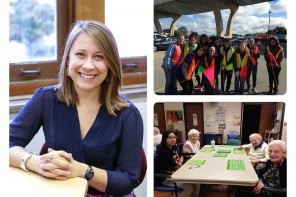 By Desiree Pointer Mace — One of my favorite e.e. cummings poems is “i carry your heart.”
By Desiree Pointer Mace — One of my favorite e.e. cummings poems is “i carry your heart.”
I’ve often thought of this poem when I think about my teaching mentors– the ways in which my own teaching is informed by the extraordinary classrooms I’ve had a chance to be in as a learner. And I carry those educators’ teaching practices– I carry them in my own teaching.
A few years ago, I had one of the most fulfilling experiences of my teaching career– to guest-teach in the classroom that served as a major inspiration for me to enter the profession– Connie Weber’s classroom at Emerson School in Ann Arbor, MI.
Around March of 2010, through intent or serendipity Connie found me on facebook and we were both delighted to learn that, since the day long ago when I was a student in her elementary classroom, I have become an educator myself and now prepare novices as a professor of Education at Alverno College.
This has been no short journey– in fact, I think it had been nearly 30 years since I’d last seen Connie. But as I had an opportunity to share with her students, some things stay the same, and some things change. I remember her classroom being one where relationships mattered– she got to know each of us as individuals, and expected us to get to know and show kindness to each other as well (as an example, one of her particular strategies– “Nice Notes in a Circle”– I conduct now in the form of end-of-seminar appreciations for the thinking of colleagues in my college courses). She expected us to learn in and out of the classroom. She expected us to show our learning in multiple ways. She was tall, and creative, and free, and she had a horse (which was *very* amazing to my ten-year-old self.)
When I learned that I’d be returning to Ann Arbor for a family visit, I asked Connie if I could come volunteer in her classroom. She responded that it would be an honor for her if I would guest teach her students– they were working on a novel and if I could read it, I could develop a lesson about its themes for them. I jumped at the chance.
The Talking Earth, by Jean Craighead George, is about a kind of “vision quest” undertaken by a Seminole girl named Billie Wind. Throughout the novel, Billie encounters various experiences that demand that she position herself between competing forces– some even elemental, as she finds safety in an underground earthen cave as a wildfire rages above her, and finds sustenance from the water next to the cave. This is not an experience likely to be shared by any of Connie’s students, but some of the other tensions Billie experiences are– those of whether to embrace family and cultural traditions or find new ways, whether to explore new worlds or get to know your own home area, whether to use existing resources or develop new tools.
I thought it would be interesting to ask the students to work collaboratively (itself a process of navigating tension) to identify the ways in which a set of competing dynamics can both have positives, and that in decision-making, individuals have to position themselves between them.
I also did a little research into Seminole culture and traditions and found that the textile art forms used by the Seminole make vivid use of oppositional colors, creating harmonic patterns out of divergent shapes and forms.
The presentation I presented asked students to identify these tensions and create a quilt square that made them visible. As they still had four chapters left to read in the book, in our sharing out I asked them to hazard some predictions about how these tensions might culminate or resolve in the rest of the book.
In my work as a teacher educator, I visit lots of different kinds of classrooms and get to see many different ways in which my students’ cooperating teachers create a learning environment– how they arrange physical space, but also how they arrange relational space, setting norms for respectful and vibrant discourse. What a feeling it was, to circulate around the students as they worked, noting that it’s still clear that the dynamics that made me feel like a creative, accountable, artistic, inquiring thinker 30 years ago are still in place in Connie’s work with her students today.
It also struck me what a powerful profession this is– that the choices we make with our students resonate so far beyond our quotidian interactions. Talk about “ripples of hope”— the many extraordinary teachers I’ve been fortunate enough to have, I carry them in my own teaching, and I pass along, I hope, equally lasting ripples in the teaching practices of my own students. I am so deeply grateful for teachers like Connie, the teachers we celebrate on October 17th. They create immeasurable impacts every day in the lives of their students.
Whose teaching practices do you carry in your own teaching?
Desiree Pointer Mace, Ph.D. is an Associate Professor and Associate Dean for Graduate Programs in the School of Education at Alverno College, and the author of “Teacher Practice Online: Sharing Wisdom, Opening Doors”. Dr. Pointer Mace’s work focuses on envisioning and inventing ways of representing teaching and learning using new media and online technologies, and advocating for high educational outcomes for all students. Dr. Pointer Mace is the conceptual architect and multimedia curator of Inside Mathematics, a project of the Noyce Foundation.

 i evaluate to yes even if there's no image
i evaluate to yes even if there's no image  i evaluate to yes even if there's no image
i evaluate to yes even if there's no image  i evaluate to yes even if there's no image
i evaluate to yes even if there's no image